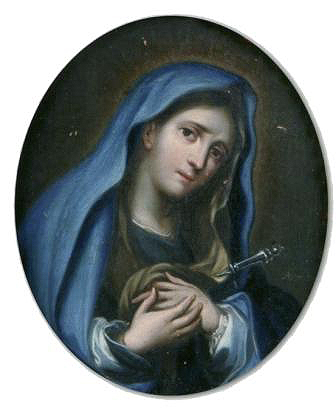The piece of the month of August 2012
A SMALL COPPER PLATE OF THE VIRGEN DE LOS DOLORES, SIGNED BY JOSÉ ALZÍBAR
Ricardo Fernández Gracia
Chair of Navarrese Heritage and Art
Among the paintings that arrived from New Spain to peninsular lands, on the one hand, the large canvases of portraits of Indians who had made degree program in those lands or of Guadalupanas, anthropomorphic Trinities and other sacred iconographies stand out. subject On the other hand, there are the small oil painted coppers that were destined to family mansions and as gifts for those who were far away or for those who came back from their Indian adventure with all kinds of sumptuary arts and artistic objects.
In Navarre, an excellent set of paintings of the Virgin of Guadalupe from Mexico, from the XVII and XVIII centuries, stands out from that provenance. They are often signed by outstanding New Spain painters such as Juan Salguero, Juan Correa, Juan Rodríguez Juárez, Francisco Antonio Vallejo, José Páez or Antonio de Torres. Most of them belong to the 18th century and their history is closely linked to that of so many other Indians who made degree program military, commercial or political in New Spain. Also worth mentioning are some outstanding portraits and the Trinities of Puente la Reina and Estella.
Regarding the coppers, they are generally small pieces that the Indianos brought with them on their return or sent them to decorate the halls of their ancestral homes, many of which they had rebuilt at their own expense. In many cases with the topic of the Virgin of Guadalupe it became part of the cultural and religious identity of those families, together with other representations of more peninsular devotions such as the Virgin of Pilar, or more regional ones such as the Virgin of the Camino, San Saturnino and San Fermín, which were also painted in New Spain, following models of Pamplona's devotional engravings. To this group belongs the beautiful copy signed by Nicolás Enríquez in 1773 and exhibited in the exhibition Pamplona y San Cernin 1611-2011. IV Centenary of the city's vow. We know small collections of coppers with four or six in each one of them, where the great novo-Hispanic and peninsular devotions are represented.
Here we present a small oval copper signed by José Alzíbar, preserved in a private collection, which represents the Dolorosa with a large sword -symbolizing the seven daggers of her seven sorrows-. Mary wears a very large blue wraparound cloak, white shirt, brown veil and dark tunic. As an iconographic particularity we must mention the delicate tears that run down her cheeks. As is known, in the time of Urban VIII this detail was eliminated from the images of the Virgin of Sorrows, on the understanding that in the stabat at the foot of the cross, Mary would have maintained her dignity as Mother of God, without special fuss or tears, as many preachers of the Baroque period point out. This model was very widespread as a devotional icon and numerous paintings with the same outline are preserved, both by great painters and other more medium-sized ones.

Our Lady of Sorrows, by José Alzíbar
Iconographically, it adapts to one of the most widespread models for showing the sorrows of the Virgin. As Juan Martínez del Llano recalls in his Marial de todas las fiestas de Nuestra Señora (Madrid, 1682): "It is most common in the paintings or carved images of Our Lady of Sorrows or of the Compassion to paint them or make them with many swords or one, ending in her heart, in which we are given to understand the knife of pain that Simeon prophesied".
The copper is signed by José Alzíbar, a Novo-Hispanic painter active between 1751 and 1808, of whom we know an abundant pictorial work, both of religious themes and portraits, which is scattered throughout Mexico. Trained in the Novo-Hispanic tradition, he witnessed and actively participated in the changes that came from Europe, such as the founding of the Academy of the Three Noble Arts of San Carlos in 1785.
